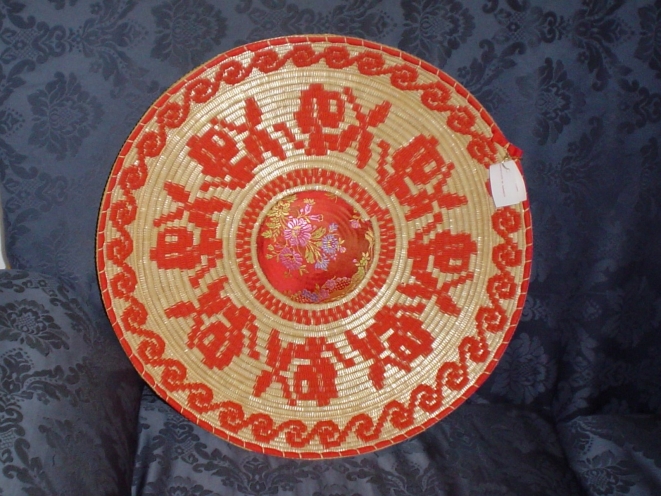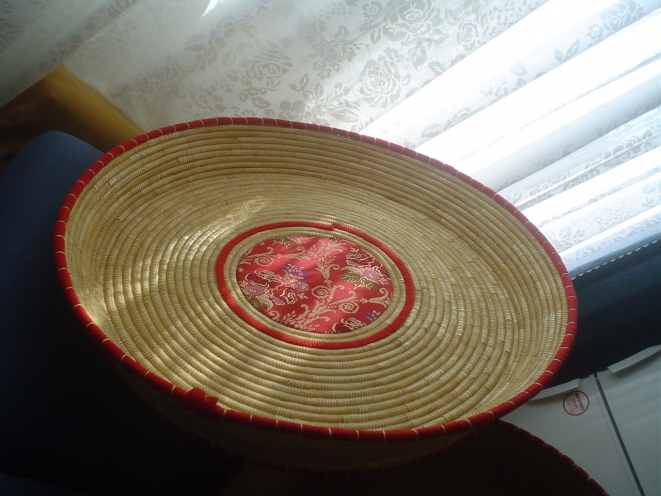The baskets of Sardinian tradition
The art of weave in Sinnai
At the foot of the promontory of Serpeddì Mountain, Sinnai rises up. It is the village of the hay and reed baskets. Here the art of weave is linked to the manual skill of a creative artist, whose passion for the handmade manufacturing of reed creates true works of art.
For twenty years Alessandra Floris has been devoting her life to create "Su strexiu de fenu", the set of baskets and sieves indispensable for the preparation of bread. Baskets made by an expert and steadfast hand, able to manage and support the natural "thread for sewing" by herself cultivated and dried, such as the reed itself, that particular plant with the etymological meaning come from the Latin verb jungere, namely "to link"; indeed, it was used ab origine for the creation of baskets and laces.
There are not equipments for working for the traditional inventor of baskets, but only a punch put between the little finger and the ring finger, aimed to assist the making of the herbaceous plant, that links to itself the hay and allows the creation of the basket on the basis of a circular way that supports the natural deploy of the typical thread for sewing.
Indeed, what marks that artisan of Sinnai is the production made of reed by herself, curated from the cultivation to the drying until the manufacturing for creating the final work of art, such as the basket of the Sardinian tradition of her village.

- The manufacturing. Made by yourself the cultivation, the drying and the preparation of reed: Mrs Floris, could you explain us which are the phases of the manufacturing of reed, so-called too "thread for sewing" of the creators of baskets?
Plantation starts in January, through a dense soling, made by hand. It allows to leave a narrow space between a seed and another, rigorously sown by hand, avoiding the growth of weeds that let die crop and preparing cultivation towards the birth of subtle stalks. Instead, for creating long stalks you need a big bush: if you have a bush with the only needle, it is a symptom of softness; on the contrary, rigidity is a feature of the bush with flower and needle. From the bush you can choose only the culms in bloom.
Reed, in spite of hay that has not to be in very contact close with humidity, needs a particularly prosperous land, namely fertilized and, above all, it needs proximity of salty water. Reed is cultivated in June, through a movement of linear and smooth extraction in order not to flex it. When they are extracted, reeds are very green and they are extracted one after one. The part that is underground is the best, because it is white. You can notice the exact degree of maturation when it is not necessary to force for extracting it and it does not present a white "shirt" as a cover anymore. So, you must remove the extremity in bloom and you must submit it to the process of drying that lasts until a month and a half. The high-quality reed less subtle will be added in the bottom of the basket, where it will be integrated the fabric, under which is usually used hay, in order not to have a basket too heavy.
- When reed is dried, is it ready for the creation of basket?
When reed is dried it must be "smazzau", namely you must remove the core until making it reach the right thickness. Indeed, for su strexiu fini you must cut it, along the length, with eight or ten parts; on the contrary, for su strexiu grossu you must reach until a maximum of four parts. You must work them singularly, because not all have the same structure of marrow and it is necessary to respect the natural wrinkles, such that sometimes some of them are not straight and therefore they must be rejected, because they would be useless for seam. For obtaining very thin stalks you must use punch, typical tool with a shape of a capital "T".
When it is worn out, it is necessary to wash it, but not through a total soak, but you must wash two fingers and touch it in a light way. It is necessary to wash it for preserving elasticity, because if it was dry it would be broken. Then, you must include it into a short bin with an aluminum bowl in the middle and containing yellow sulfur; on the contrary, reed stays along the sides in order not to touch the bowl. You must set fire to the sulfur keeping the bowl partially covered: the effect of smoke consists in a disinfectant and whiten action.

- The other material typical of the basket and used by you is the hay. What is the meaning of "sheaf"?
It is a bundle of rough hay to work, cut through sickle, from which you can obtain sa mannuga, namely the amount of stems of wheat that can stay on a hand. You must put them straight "spike on spike" because, on the next phase of beating, you hit only the head of spike. The inflection must be light, you cannot break grain, but you must extract smoothly. Finished the beating, you must put the bundle back together in a linear way through two laces and you must cut excess, for then linking it to others and making the bundle. When it is ready, it will be deprived of the so-called "shirt", a cover that protects it from the sun.
- Which are the varieties of baskets of Sardinian tradition realizing by you?
There is a difference between su strexiu grossu and su strexiu fini. Both the kinds have both the concave shape and that flat with a different size. There is a difference because the first one has the big crown, big dots and the thickness of reed is big. Moreover, the fabric used is usual, with a whatever color and without a drawing. Traditionally, it was decorated with a cotton ribbon both on the upper side and on the foot. Among the baskets with a flat shape we have the Palinedda that changes the name, according to the size, in Palini and Canisteddu. Instead, about the baskets with a concave shape we have sa Crobixedda and Sa Crobi manna. They are some bins that were used for bread and fresh dough. The flat shape needed to make bread rise that, once was cooked was put in that concave. Instead, Sa disqua, is a basket with a basis connection that needs to drain the liquids of cheese. Indeed, it is made only with reed, that, being born in damp land, reacts well to the product. Instead, Su strexiu fini, operated as a decoration, for the dowries of children of well-off families. It is characterized by the use of brocade, the scarlet red and the scenes of hunting and dancing. Among the kinds we can recall the cake dish, sa pallinedda, sa crobedda, su coffinu and the oval.
- For your creation do you use the colored reed, too?
Yes, I attended a course for learning the techniques for the dye of natural fibers. Through the colored reed, ornamentation must have wide and little detailed patterns, otherwise there is the risk that they are messy. For instance, the cranista is made through the colored reed, originally with a round or oval shape with a blue or pink lining and various expressions as decoration. It is destined to include the first dowry of newborn.
- About your main artisan activity, namely the creation of the typical baskets of Sinnai, what is the news?
I realize clocks, mirrors, jewels and covers for bags through the same materials of the Sardinian traditional baskets; furthermore, I do activities of restoration of ancient baskets. So, a traditional activity that today is linked to new works of art, letting living again, in the weave of baskets, the culture of a village well-known for its dedication to the craft and the culture of the Island.